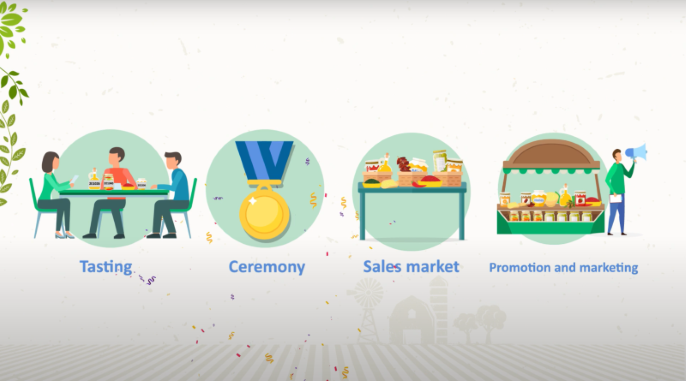The Contest is designed, organized, and run for and with consumers. It consists of 4 different phases:
- The Contest, including anonymous degustation and selection of the medal-winning products;
- The medal ceremony with strong media coverage;
- The marketplace and trade fair with all products available for testing and selling;
- Marketing medal-winning products in national and international fairs.

This being said, the additional indirect impacts on sector structure, typical products development and quality improvement can also be substantial.
A National Contest tasting is markedly hedonic but also has an analytic component. Its main goal is to make the finest products emerge from the bulk of products competing in the various categories, so as to inform consumers, while also identifying product qualities and defects, to notify producers. The process concludes with extensive communication on medal-winning products, as well as feedback to all participating producers.
The tasting is conducted based on appearance, smell, and taste.
Each tasting table includes:
- 1 specialist from the product “branch” (researcher, research organization collaborator, tasting expert in the “branch”, taster accredited by a national or international organization, etc.);
- 1 producer in the sector or “branch” of the product;
- 1 consumer interested in regional products. These consumers may also be journalists.

Medals are awarded according to scores given by juries.
The National Contest for typical Products is equally beneficial for:
- Medal awarded producers since they gain on visibility thanks to the promotion linked to the National Contest and its market, but also after the event by using the medals and participating to national and international exhibitions and markets. A study on the awarded producers in Morocco and Tunisia showed that award winners increased their turnover by 30-40% ;
- Producers that participated in the contest but did not win a medal, as the Contest provides them direct feedback on how to improve the quality of their products and to correct sensorial defaults;
- Buyers (both national and international), as the Contest provides an easy way for them to identify the best products;
- Consumers, as the Contest and the market related to it allow them to identify the best products and to strengthen the link between producers and consumers. Also, the media campaign run in parallel and after the contest helps to generate a demand for the award-winning producers and to familiarize the consumers with the typicity of the products and their specific characteristics;
- Regions and areas involved, as the Contest triggers positive competition among them and gives an opportunity for regions to locally promote medal-winning products, and to emphasize local producers’ know-how. This is an essential effect since typical products are generally sold primarily in the region of origin;
- Sector structure, as the Contest can strengthen linkages within a given value chain and also trigger potential cooperation and positive competition among producers.

